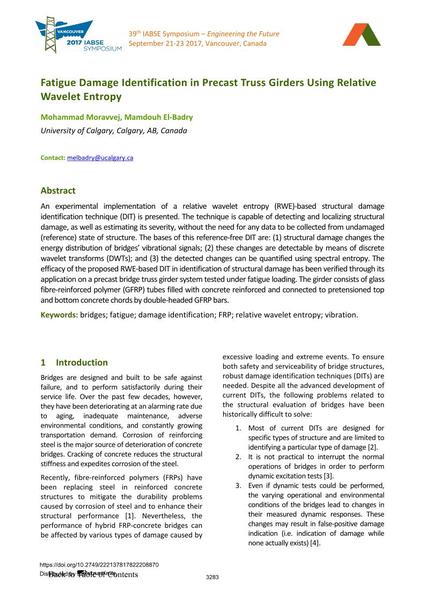Fatigue Damage Identification in Precast Truss Girders Using Relative Wavelet Entropy

|
|
|||||||||||
Détails bibliographiques
| Auteur(s): |
Mohammad Moravvej
(University of Calgary, Calgary, AB, Canada)
Mamdouh El-Badry (University of Calgary, Calgary, AB, Canada) |
||||
|---|---|---|---|---|---|
| Médium: | papier de conférence | ||||
| Langue(s): | anglais | ||||
| Conférence: | IABSE Symposium: Engineering the Future, Vancouver, Canada, 21-23 September 2017 | ||||
| Publié dans: | IABSE Symposium Vancouver 2017 | ||||
|
|||||
| Page(s): | 3283-3290 | ||||
| Nombre total de pages (du PDF): | 8 | ||||
| Année: | 2017 | ||||
| DOI: | 10.2749/222137817822208870 | ||||
| Abstrait: |
An experimental implementation of a relative wavelet entropy (RWE)-based structural damage identification technique (DIT) is presented. The technique is capable of detecting and localizing structural damage, as well as estimating its severity, without the need for any data to be collected from undamaged (reference) state of structure. The bases of this reference-free DIT are: (1) structural damage changes the energy distribution of bridges’ vibrational signals; (2) these changes are detectable by means of discrete wavelet transforms (DWTs); and (3) the detected changes can be quantified using spectral entropy. The efficacy of the proposed RWE-based DIT in identification of structural damage has been verified through its application on a precast bridge truss girder system tested under fatigue loading. The girder consists of glass fibre-reinforced polymer (GFRP) tubes filled with concrete reinforced and connected to pretensioned top and bottom concrete chords by double-headed GFRP bars. |
||||
| Mots-clé: |
ponts
|
||||
